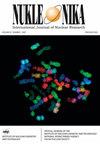燃料类型对球床堆控制棒反应性的影响
IF 0.3
4区 物理与天体物理
Q4 CHEMISTRY, INORGANIC & NUCLEAR
引用次数: 10
摘要
控制棒反应性作为堆芯重要的物理参数,是反应堆控制和安全运行的关键。本文研究了在不改变堆芯结构的情况下,UO2、(Th)O2、U)O2和PuO2三种燃料类型下球床堆控制棒反应性的计算。反应器模型选用HTR-10的反应器几何形状。控制棒反应性的整个计算是使用带有ENDF/B-VII库的MCNP6代码完成的。计算结果表明,UO2-、(U,Th)O2-和puo2燃料堆芯中控制棒的总反应性值分别为15.87、15.25和14.33%Δk/k。结果表明,总控制棒在钍、铀堆芯中的效果与钚堆芯的效果基本相同,但高于钚堆芯。单个控制棒在铀、钍和钚堆芯中的最高反应性值分别为1.64、1.44和1.53%Δk/k,分别对应于CR8、CR1和CR5。结果表明,在UO2-、(U、Th)O2-和puo2燃料堆芯中,分别采用CR3+CR5+CR8+CR10、CR2+CR3+CR7+CR8和CR1+CR3+CR6+CR8的控制棒组合可以实现反应堆的安全停堆。可以得出结论,尽管计算结果相差不大,但在不同燃料类型的球床堆芯设计中,控制棒的选择是需要考虑的。本文章由计算机程序翻译,如有差异,请以英文原文为准。
The effects of fuel type on control rod reactivity of pebble-bed reactor
Abstract As a crucial core physics parameter, the control rod reactivity has to be predicted for the control and safety of the reactor. This paper studies the control rod reactivity calculation of the pebble-bed reactor with three scenarios of UO2, (Th,U)O2, and PuO2 fuel type without any modifications in the configuration of the reactor core. The reactor geometry of HTR-10 was selected for the reactor model. The entire calculation of control rod reactivity was done using the MCNP6 code with ENDF/B-VII library. The calculation results show that the total reactivity worth of control rods in UO2-, (U,Th)O2-, and PuO2-fueled cores is 15.87, 15.25, and 14.33%Δk/k, respectively. These results prove that the effectiveness of total control rod in thorium and uranium cores is almost similar to but higher than that in plutonium cores. The highest reactivity worth of individual control rod in uranium, thorium and plutonium cores is 1.64, 1.44, and 1.53%Δk/k corresponding to CR8, CR1, and CR5, respectively. The other results demonstrate that the reactor can be safely shutdown with the control rods combination of CR3+CR5+CR8+CR10, CR2+CR3+CR7+CR8, and CR1+CR3+CR6+CR8 in UO2-, (U,Th)O2-, and PuO2-fueled cores, respectively. It can be concluded that, even though the calculation results are not so much different, however, the selection of control rods should be considered in the pebble-bed core design with different scenarios of fuel type.
求助全文
通过发布文献求助,成功后即可免费获取论文全文。
去求助
来源期刊

Nukleonika
物理-无机化学与核化学
CiteScore
2.00
自引率
0.00%
发文量
5
审稿时长
4-8 weeks
期刊介绍:
"Nukleonika" is an international peer-reviewed, scientific journal publishing original top quality papers on fundamental, experimental, applied and theoretical aspects of nuclear sciences.
The fields of research include:
radiochemistry, radiation measurements, application of radionuclides in various branches of science and technology, chemistry of f-block elements, radiation chemistry, radiation physics, activation analysis, nuclear medicine, radiobiology, radiation safety, nuclear industrial electronics, environmental protection, radioactive wastes, nuclear technologies in material and process engineering, radioisotope diagnostic methods of engineering objects, nuclear physics, nuclear reactors and nuclear power, reactor physics, nuclear safety, fuel cycle, reactor calculations, nuclear chemical engineering, nuclear fusion, plasma physics etc.
 求助内容:
求助内容: 应助结果提醒方式:
应助结果提醒方式:


